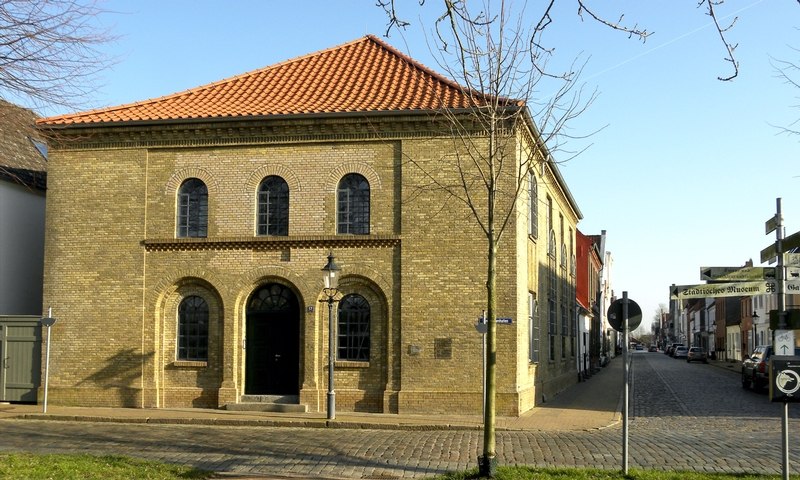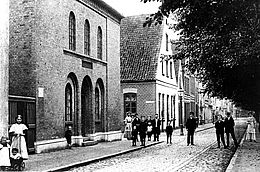In the nineteenth century Friedrichstadt was known as the 'City of Tolerance'. The local tourist board has purloined the phrase as a strap line - but it's not merely marketing gobbledygook, it has an historical basis. Friedrichstadt was founded in the early seventeenth century when Frederick III, Duke of Holstein-Gottorp invited a group of Dutch protestants to establish a new town.
The settlers, a mixture of Mennonites and Remonsrant worshippers, suffered religious persecution in the strictly Calvinistic Netherlands. They established Friedrichstadt as place of religious tolerance; eventually the population included Lutherans, Roman Catholics and Jews - a rare example of diversity in an age characterised by schism.
Is it fanciful to think that this quest for harmony is reflected in the design of the town? Built on a clear rectilinear grid around a network of canals, the place does exude a sense of calm. The cobbled streets mainly consist of typically Dutch stepped gabled cottages, most buildings are modest in scale. The only spots that reach towards any sense of grandeur are the spacious main square and the Remonstrant's imposing church.
I think they were making a point, the town may have prided itself on religious tolerance, but the Remonstrants here seem 'first among equals'. To this day the congregation is the largest outside Holland, though admittedly, there are only 10,000 or so 'Remonstrants' in the world these days, so it's a bit of a 'niche' sect. It has a great name though!
Duke Friedrich had big plans for the place hoping to do a Trump style deal with the Tsar to create a northern trade route to Persia and the east through the Baltic and Russia. When that failed to materialise Friedrichstadt established itself as a prosperous lace making town.
These days tourism is the main occupation, around the main square there are many tempting looking cafés, a gelateria or two and a nice craft bakery. Fish sandwiches are the town's takeaway snack of choice, but as it was mid-morning I did not quite feel up to sampling this particular local speciality.
It is all very lovely, but the town has a dark history too, quite at odds with its 'city of tolerance' image. The 'Ehemalige Synagoge' lies on a quiet street on the western edge of the old town overlooking a tree shaded canal. It's not a big building but it has a certain presence, standing out from the houses next to it, a handsome, well proportioned mid nineteenth century edifice quite different to the neighbouring vernacular style brick cottages. Erected in 1847 it testifies that at that point Friedrichstadt's Jewish community was thriving.
In the early 1920s a local newspaper reported the words of of a visiting Rabbi's reflection on the history of the building :
"He developed in broad terms the conditions of disenfranchised Jews in the 17th century, and showed how Friedrichstadt became a religious free city for all those persecuted, including Jews. So it comes that even today 5 different denominations live in this small town, which show mutual respect. Hatred of the Jews and intolerance have remained unknown here. The German lives peacefully with the Jew, the Lutheran encounters Catholics, Remonstrants, Mennonites in harmony. Speakers emphasised that charity is an old requirement of Jewish teachers and, especially for our time, an important feature."
Sadly the situation described here was on a collision course with history. Along with most other synagogues and Jewish businesses in the country the Jewish population of Friedrichstad was attacked in November 1938. Their shops and the synagogue were wrecked. Within two years the entire local Jewish community had been removed to concentration camps. In 1942 the building was restored as an apartment for the family of a senior SS officer who wished to relocate his wife and young daughter from the area around Hamburg which was under nightly attack from allied bombers.
The grim irony of this is inescapable, but there is an optimistic twist to the building's story. Heike Mundzeck is journalist from Hamburg who during the 1970s and 1980s made numerous award-winning documentaries about the children of former Nazi perpetrators and their victims. Her 'moment of shame' occurred when her own research revealed that the 'yellow house' she remembered living in with her mother when she was six was in fact the apartment constructed in the ruins of Friedrichstad's synagogue; her father was the SS officer who had converted the building in 1942.
"Who lived in the synagogue of Friedrichstadt?" the film Heike Mundzeck made about the discovery is described by a reviewer as "a committed and moving recording, without the usual accusation rhetoric, the search for traces of one's own past, biography as time exploration. Above all, it was about the reconstruction of everyday life, about the coexistence of Jews and Christians until the pogrom night of 1938.'
 |
| Heike Mundzeck receiving an award for her 'courageous journalism' |
In 2001 the 'Ehemalige Synagoge' was converted into a cultural centre and small performance space. Additionally it runs education events for older school children based around Heike Mundzeck's film encouraging them to acknowledge the horrors of the past and the importance of confronting them honestly to seek peace and reconciliation.
There are of many places that commemorate the Holocaust - the large memorial in Berlin and Auschwitz in Poland come immediately to mind - in fact almost 40 countries have memorials and museums, which is as it should be given the scale of the genocide. If Auschwitz reveals the industrial scale of the slaughter, then the Friedrichstad synagogue commemorates the opposite end of what might be regarded as a 'supply chain of evil'. The journey of each of the six million people killed in the death camps began with a smaller act of brutality in their home community. Given the idyllic location of the building and the fact that the town itself was founded upon principles of tolerance the story of the Ehemalige Synagoge seems especially poignant. I was left reflecting that great acts of evil are not merely the result of abstract forces such as 'history' or the the fault of inhuman ideologies like Fascism, they also happen through the accumulation of innumerable small acts of inhumanity perpetrated by ordinary people, reminding us that we are all responsible and culpable for what happens in the world and the dangers of seeing things in black and white, a matter of us and them.












No comments:
Post a Comment